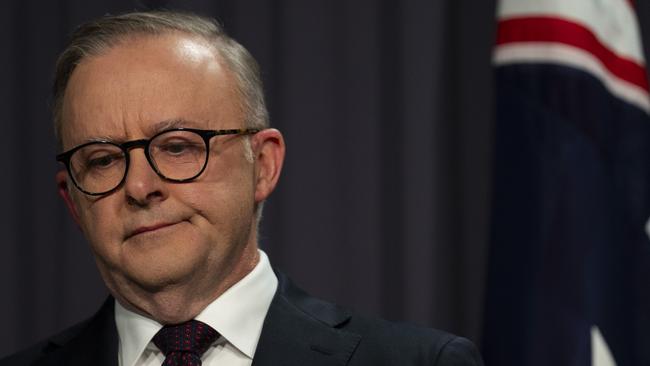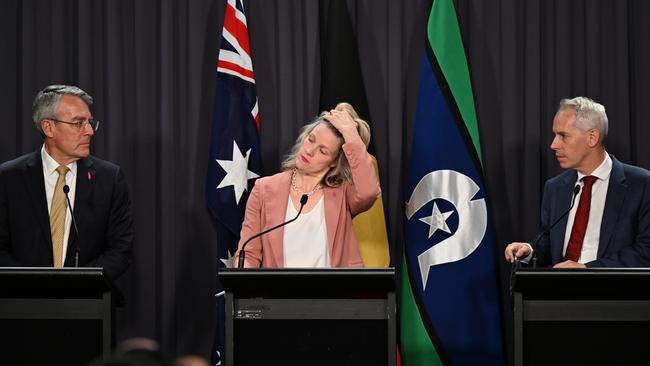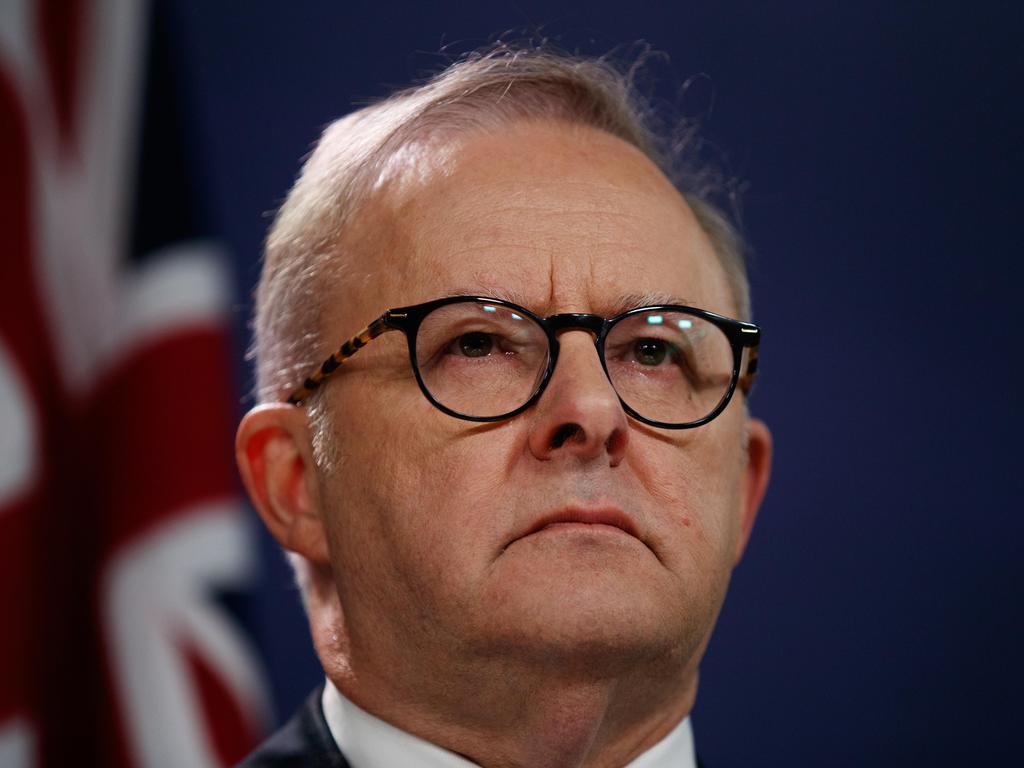A new year’s wake-up call for Anthony Albanese
The voice debacle exposed how out of touch Labor is with voters. Is that tin ear for voter sentiments isolated to the referendum question?

The polls tightened – both the party vote and the better prime minister ratings. Labor’s primary vote now trails the Coalition’s. The Prime Minister’s net satisfaction rating is in negative territory and on a downward trajectory. To be sure, Peter Dutton is far from popular, but banking on the Opposition Leader’s unpopularity as the ticket to a successful Labor re-election campaign doesn’t look as certain as it once did.
The Indigenous voice debacle has exposed how out of touch Labor is with mainstream voters. What remains to be seen is whether that tin ear for voter sentiments is isolated to the referendum question. It was a signature policy that was defeated overwhelmingly in every state.
Although the voice was a policy goal Labor took to the 2022 election, it was hardly the focus of people’s attention. Labor won then on a mantra of removing the Coalition from power after a disappointing three terms in office. Support for Albanese largely was focused on the fact he wasn’t Scott Morrison, who by the end of his prime ministership was deeply unpopular. Labor’s plans to deploy the same strategy against Dutton may need a rethink.

First-term federal governments rarely lose re-election. The last one-term administration federally was James Scullin’s Labor government, defeated at the 1931 election. The Labor Party split as the world was being engulfed by the Depression. Whatever the tensions within modern Labor, including challenges posed on its left flank by the rise and rise of the Greens, for example, the party isn’t about to split. And while the global economy is under significant pressure, things aren’t anywhere near as bad as they were in the 1930s.
But to lock in a successful re-election the Labor government needs to find a purpose, and with the challenging conditions ahead that purpose needs to be in economic policy. Albanese may be the only member of the powerful expenditure review committee with an economics degree, but economics is hardly his passion. Social justice drove him into politics and sustained his activism, which is why the defeat of the voice was such a body blow, however much he may like to claim otherwise now.
In the referendum’s wake things went from bad to worse for Labor. The cost-of-living crisis worsened as rate rises and high inflation persisted. The acuteness of the housing crisis took centre stage as state Labor governments sought to enact policies to address a problem the federal government couldn’t.
Concerns about historically high rates of immigration grew, forcing an about-face by the federal government as it announced plans to curb its rise. High immigration has long been the bedrock of sustained economic growth in this country. It has been used by consecutive governments to prop up budgets, alongside the ever encroaching role of bracket creep. It is likely next year will be dominated by debates surrounding how best to traverse the economic challenges the nation faces. Recent polling highlights voters once again trust the Coalition as the better economic manager over Labor, after a brief reversal of that trend shortly before and after the 2022 election.

To be sure, any economic debate needs to include a discussion on the role of industrial relations, a policy area Labor has been active in during its first term. Employment and Workplace Relations Minister Tony Burke has sought to tackle diminishing worker rights and conditions in the age of the gig economy, but his policy settings have had some unintended consequences. For example, efforts to give contract employees greater rights by forcing businesses to transfer their employment status to ongoing has resulted in contracts not being renewed, hurting the employees Burke hoped to help. This particularly has been the case in the higher education sector, for example, but it is an issue across industries.
As much as the IR debate should be a policy battleground next year, it will be trench warfare at most. Business is becoming louder, expressing its concerns at what Labor is doing, and the crossbench has joined the opposition to force some legislative amendments to Burke’s second round of changes. But Dutton is unlikely to stake his claim for the prime ministership on an IR agenda Labor can easily target a scare campaign against. Instead Dutton will seek to win voters over other areas, focusing on government deficiencies rather than alternative policy initiatives.
One of those debates is certain to be border protection. The year has ended badly for Labor with a High Court decision leading to the release of more than 100 stateless illegal migrants. Many had rap sheets including murder, sexual assault and child sex convictions. The government was ill-prepared for the judgment despite warnings it was imminent and bureaucratic advice on how to minimise its effect. Despite efforts at post-release surveillance, some of those released into the community were lost, and others are facing allegations of having reoffended.
Rather than admit to poor management, the responsible ministers went on the attack, accusing the opposition of wanting the government to ignore the judgment of the courts or making political capital out of a sensitive policy issue.

Home Affairs Minister Clare O’Neil refused to answer direct questions in the final sitting weeks of the year. The optics were terrible. Attorney-General Mark Dreyfus had to apologise to a journalist he aggressively targeted at a media conference because he didn’t like her tenacity. Immigration Minister Andrew Giles, directly responsible for what transpired, wouldn’t confirm the timing of what he knew and when, as the country tried to piece together how it happened.
Suffice it to say Labor needs an early reset in 2024 to get its re-election hopes back on track.
While no first-term government has lost re-election in nearly a century, recent administrations have come close. The last Coalition government in its first term scraped home in 2016 with a one-seat majority. Labor was returned in 2010 as a minority government. John Howard’s 1998 re-election was successful but with less than 50 per cent of the two-party vote, sandbagging key marginal seats to retain a somewhat healthy majority. Even Bob Hawke’s 1984 re-election saw opposition leader Andrew Peacock exceed expectations.
Hawke called an early election in 1984, and after Labor’s victory in 2022 there was speculation Albanese might look to do the same, shifting the next election campaign to the end of 2024 or early in 2025.
The last two campaigns (2019 and 2022) have resulted in unusual May elections, getting in the road of the budget countdown and its aftermath. An election within the next 12 months now seems likely after the travails Labor has endured to end the year, but it will hope to improve its electoral fortunes in time to bring the next poll forward to February or March 2025 to avoid needing to hand down more than one budget between now and polling day. That would make the coming budget the last before an election.
Jim Chalmers has sought to win applause for delivering a surplus this year followed by mid-year economic and fiscal outlook estimates of a balanced budget next year. But these short-term numbers, propped up by bracket creep and higher than anticipated commodity prices, won’t last for long. The out years see a return to deficits. The economic climate requires innovation by government, but beyond the charade of media profiles and spinning the budget outcomes, the Treasurer has shrunk rather than grown into his role.
There are few signs of big-ticket reforms to be wheeled out ahead of the next election campaign. Stage three tax cuts will take effect next July, but they were legislated well in advance by the previous government. History tells us new governments get only a small window to make their mark before losing office or going into survival mode.
The Hawke and Keating governments set the benchmark for major economic reforms during the heady days of the 1980s.
The Howard and Costello government updated the tax system for the turn of the century, introducing a GST.
The Rudd and Gillard governments sought to modernise how Australia responded to climate change, only to lose the 2013 election and have their legislative legacy repealed.
Tony Abbott’s legacy could have been budget repair had Joe Hockey’s first budget not been so badly received, setting off a series of leadership changes.
Was the voice this government’s only major attempt at a policy legacy, or is there more to come beyond piecemeal adjustments driven by the public service?
The energy and climate change agenda is bold but risky, with no guarantee the targets will be reached. Energy Minister Chris Bowen is an outlier in his willingness to think big, not that the mining industry sees it that way.
The current crop of cabinet ministers is dominated by ministerial survivors from the Rudd and Gillard years who felt those six years were a missed opportunity. This group includes Albanese, who was leader of the house before briefly serving as deputy prime minister to Kevin Rudd in his second coming.
Sticking around for a second tilt at government, will this collective seek to make their mark by mounting a reform agenda Hawke and Paul Keating would be proud of? Or did they learn a different lesson from the two-term Labor government they were part of?
The next 12 months will be dominated by the cost-of-living crisis and what, if anything, politicians can do to alleviate it. The search for votes will likely see government spending used as a blunt instrument to help struggling families.
The necessary longer-term changes required to lift productivity and better structure an increasingly antiquated tax and transfer system don’t deliver immediate electoral returns, remembering Labor’s majority is slender.
Perhaps the biggest barrier to this government doing more than aiming to survive is its tight electoral margin. Winning 77 of 151 seats at the 2022 election was a narrow victory, even if the rise of the teals reduced the Coalition to 55 seats.
Labor’s win at the Aston by-election while still enjoying a political honeymoon lifted its share of seats to 78, but that was still a slender majority. With redistributions due in NSW, Victoria and Western Australia before the next election, uncertainty abounds. If Labor loses seats without winning Coalition seats in a state such as Queensland it will lose its majority, forcing it into negotiations with the Greens to form a second-term minority government.
Some in the Coalition believe this is Dutton’s strategy: don’t target former blue-ribbon seats that are now teal but retain existing seats and aggressively focus on outer metropolitan marginal electorates held by Labor. It is a binary decision because the dividing lines between progressives and conservatives are growing; between inner city and outer metro and regional voters. While it is easy to see Labor struggling to retain majority government, it is hard to see the Coalition winning enough seats to govern in its own right.
That leaves Labor in the electoral box seat, but this horse-race style of politicking does little for struggling voters. If their struggles determine how they vote, they are likelier to blame the government for their woes than the opposition.
We are living through times requiring bold political leadership, but there are few signs either major party will answer that need next year. Nevertheless, the political contest will be fierce.
Peter van Onselen is a professor of politics and public policy at the University of Western Australia.








The year 2023 can’t come to an end quickly enough for the federal Labor government. After securing a slender majority at the 2022 election, Anthony Albanese steadily built his popularity for the remainder of that year, extending the government’s lead over the newly minted Coalition opposition. But that all came crashing down with the defeat of the voice referendum.